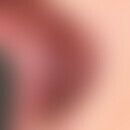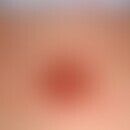Synonym(s)
HistoryThis section has been translated automatically.
DefinitionThis section has been translated automatically.
Nevus spongiosus albus mucosae is a rare (harmless), autosomal-dominant inherited keratinization disorder affecting the non-keratinized, stratified squamous epithelium of the mucous membranes. The oral mucosa is mainly affected. More rarely, the anal and vaginal mucosa and the nasal mucosa are also affected to varying degrees.
You might also be interested in
EtiopathogenesisThis section has been translated automatically.
Autosomal dominant inheritance; causative mutations are present in the KRT13 and KRT4 genes, which are mapped on chromosomes 17q21-q22 and 12p11.2-q11, respectively (nucleotide substitution from G to A in position 1345 of the KRT4 gene). To date, 6 mutations have been detected. The mutations lead to the formation of defective keratin proteins and consequent disruption of keratin filatments (Westin M et al. 2018).
ManifestationThis section has been translated automatically.
LocalizationThis section has been translated automatically.
ClinicThis section has been translated automatically.
HistologyThis section has been translated automatically.
Significant acanthosis, intra- and extracellular edema with vacuolisation of epithelial cells, parakeratosis, inflammatory infiltrate. Epidermolytic hyperkeratosis has also been described.
Differential diagnosisThis section has been translated automatically.
TherapyThis section has been translated automatically.
Progression/forecastThis section has been translated automatically.
Cheap. The changes of the oral mucosa reach their maximum expression in the 2nd decade of life. After that they do not change any more.
LiteratureThis section has been translated automatically.
- Aloi FG et al (1988) White sponge nevus with epidermolytic changes. Dermatologica 177: 323-326
- Cannon AB (1935) White sponge nevus of the mucosa (nevus spongiosus albus mucosae). Arch Dermatol Syph 31: 365
- Chao SC et al (2003) A novel mutation in the keratin 4 gene causing white sponge nevus. Br J Dermatol 148: 1125-1128.
- Mostaccioli S et al (1997) White sponge nevus is caused by mutations in mucosal keratins. Eur J Dermatol 7: 405-408
- Schaarschmidt H et al (1992) Nevus spongiosus et albus mucosae. Dermatol 43: 35-37.
Westin M et al (2018) Mutations in the genes for keratin-4 and keratin-13 in Swedish patients with white sponge nevus. J Oral Pathol Med 47:152-157.
Incoming links (6)
Dyskeratosis hereditary benign intraepithelial; Keratin; KRT4 Gene; Mucosal nevus, white; Pachyonychia congenita; White folded gingivostomatosis;Outgoing links (9)
Acanthosis; Cryosurgery; Edema; Electrocoagulation; Hyperkeratoses; Laser; Leukoplakia; Leukoplakia oral (overview); Punch biopsy;Disclaimer
Please ask your physician for a reliable diagnosis. This website is only meant as a reference.





